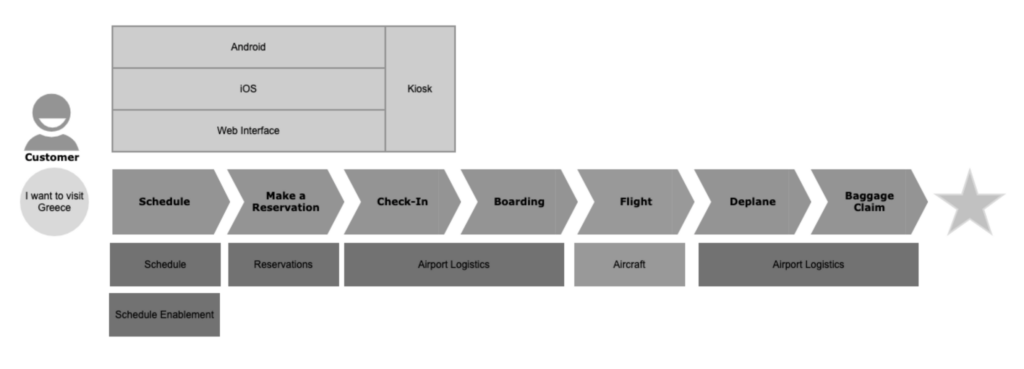Identifying and Defining Products
Identifying Products
Maximizing customer value and increased speed of delivery are two benefits often seen by companies after moving to a product-centric application delivery model. This is possible because product thinking provides teams, or programs, a shared vision and a shared understanding of not just the product, but the customers and the markets they serve. This enables teams to learn and adapt to market changes faster than they could in a project model. As a result, teams spend more time focused on building the right thing and less time creating waste (the stuff people don’t want).
If you want to achieve the benefits of a product-centric model, but are overwhelmed by where to start, continue reading. In this post, I present an approach to identifying products you can use to launch your journey.
My favorite definition of Product is “The thing you build, or service you provide, that impacts people.” It’s simple, easy to remember, and cuts to the point. But in the digital age, where much of what we create impacts people, what makes a product? Is this blog post a product? Is a marketing campaign a product? What about a support ticket; support is a service and the ticket resulted in a customer satisfaction survey. Does that make support a product? Is everything you do “a product” or only the tangible things a customer buys?
Product identification is often a challenge especially for complex organizations or those that grew quickly through mergers and acquisitions. The complexity of organizations and the bureaucracy created through organizational structure often makes product identification a struggle (on a good day).
When identifying products, it helps to think about your business from the customer’s perspective. The following 4 steps provide a framework to help organizations identify products and establishes the mindset necessary to become a product-centric:
- Understand the value your organization delivers to its customers.
- Identify how value flows through the organization
- Consider how value is delivered to your customers
- Consider how those products are enabled
Understand the value your organization delivers to its customers
In the late 90s I worked for Delta Technologies, the IT arm of Delta Airlines at the time. Like many companies at the turn of the century we were project based. I’ll use this experience to provide an example of how one might identify products by taking a customer first approach. Any resemblance to Delta’s current products, or those of any other airline, is coincidental.
A flight between two locations is the primary value customers receive from an airline. But several steps are necessary for a customer to realize this value. Each of these steps is an opportunity for the airline to impact their customer.
Identify how value flows through the organization
The first opportunity occurs when an individual decides to take a trip and realizes that the airline can get them there at a convenient time for an affordable price. Once the decision is made, the next opportunity occurs when the person books the flight. Finally on the day of travel there are several opportunities: check-in, boarding, the flight, deplaning and baggage claim. This customer experience can be visualized as follows:
The customer centric approach yields seven opportunities to impact our customers or potential customers. Now we need to look at how value is delivered to our customers.
Consider how value is delivered to your customers
Implementation choices determine how, and to what degree, a company serves the needs of their customers. In the digital world, these decisions also create products. An airline may choose to build siloed applications for each opportunity or one monolith to service everything but the actual flight. Another airline may identify key services and build multiple interfaces to target specific users (customers vs internal agents).
The image below illustrates how an airline might deliver value to its customers. There is a dedicated solution used to create a schedule and a dedicated reservation system used by call center employees to create reservations on behalf of customers. Airline employees working at the airport use an airport logistics system to serve customers at check-in, boarding, deplane, and baggage claim. Additionally, there are web and mobile solutions and a kiosk for customers that want to self-serve. Finally, there is an aircraft to take customers to their destination.
When considering how value is delivered, focus on the needs of the business customer. To meet those needs you may identify a solution that has an internal customer. For example, the immediate customers for the Airport Logistics product are airline employees, but these employees are there to provide value to the flier (the business customer).
Consider how value delivery is enabled
All of the products we’ve identified so far impact the customer either directly or indirectly. Our last step considers how the business enables value delivery. Products that fall into this category are used by employees to enable a customer facing product. Internal products are like supporting cast in a movie; they are an important part of the story and necessary for the main character to accomplish their goal; but the story is about the main character. Since internal products are sometimes bought (i.e. using ZenDesk to enable customer service), we only want to consider bespoke solutions created to meet specific business needs. /span>
At Delta Technologies, I was part of the Network Management group. The network we managed did not consist of routers and cables, but rather flight routes, airplanes and crews. We served a department in Delta Airlines that was responsible for creating the schedule. Their goal was to maximize value for the airline by determining when and where planes flew.
A lot of work goes into creating a schedule besides choosing desirable cities. There are airport restrictions and regulations on crew and equipment that must be considered. In addition, airlines enter partner agreements in order to serve more markets. These agreements come with restrictions that must be considered as part of creating a schedule. Finally, schedules are not static, they represent a plan; weather, sickness, and maintenance issues all contribute to delays and cancellations that impact what actually happens. When these events occur, temporary schedules are put in place, and passengers re-accommodated, to get everything back on track.
As with the previous step, implementation choices drive products. Back in the 90s we worked on projects to create various solutions to manage the inputs used to generate a schedule. A straightforward approach to product identification would be to consider each of those solutions a product. But we need to ask ourselves if that approach creates a structure that enables us to provide maximum value to the customer (internal and/or external)? It might, but another approach would be creating a product team capable of supporting all existing solutions but charged to optimize the system to maximize value delivery. The latter approach solves a system problem by creating a team focused on the outcome of generating a better schedule instead of optimizing a single input.
Wrap-up
Let’s recap the products we were able to identify in this fictitious airline example.
The value to our customer is a flight between two locations. To achieve this value, the customer needs a schedule, to make a reservation, to check-in, to board, to travel, to deplane, and claim their bag if one was checked. These are the products that enable value to flow through our organization.
In our example, those products were delivered by the scheduling system, a reservation system, an airport logistics system, and an aircraft. Additionally the customer could self-serve using a web interface, mobile applications and a kiosk at the airport.
We only considered how value delivery was enabled for the Scheduling aspects and that exercise resulted in one product. This product consists of several applications working together to enable the schedule.
The complete product map is illustrated in the following image.
Conclusion
Don’t let the task of identifying products in your organization overwhelm you. Start with an understanding of the value your organization delivers to its customers and identify how that value flows through the organization. Next consider how that value is delivered to your customers. Finally, consider how the products you’ve identified are enabled. When considering internal products, start with the obvious and then optimize for the system. One final tip: don’t do it alone. Successful transformations, like successful product development, begin with a cross-functional team collaborating to solve a problem. If you are interested in learning more or want guidance in your product-centric transformation, let us know. Cprime has people with the skills and experience to help.






